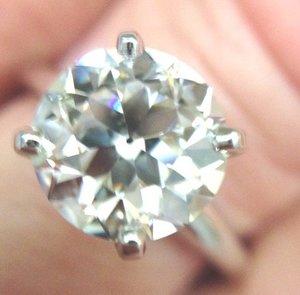Eady
Rough_Rock
- Joined
- Apr 6, 2017
- Messages
- 98
Hi,
I'm hoping this is the best place to post for some advice.
6 years ago my husband and I bought my engagement ring. It was sold to us as an antique ring with a 1.12ct solitaire I vs1 no fluro. It came with a GIA cert, and the jeweller provided a valuation for insurance purposes.
Since then I have started building my coloured stone collection, and recently dropped in some rings to an independent valuer. While I was there I asked that my engagement ring be valued as well to update the insurance. I included the GIA cert.
The valuer has since come back saying the stone in my ring is not the stone in the certificate. She was very certain - the stone in the ring is approx .96ct, E colour, vs1, faint fluro...
When my husband and I were ring shopping, we wanted a stone over a carat, and purchased this particular one because it was certified.. For us to find out we did not buy what we thought we did, given the amount paid, is a bit upsetting!
With the benefit of hindsight we should have gotten the ring checked before purchasing it, but we were expecting the jeweller who was selling us the ring to know what he was selling..
What should we do next?
I love my engagement ring, but did we over pay for it? Considering we were paying for 1.12ct I and got .96ct E? Does the better colour negate the smaller size?
Should we ask for the current stone to be certified at the cost of the jeweller?
Should we ask to exchange the ring for one that's over a carat with the correct certificate?
Should we ask for a refund (although I'm assuming diamond prices have gone up since we purchased it and we wouldn't be able to buy something comparable for the same price)?
Do we do nothing?
Thanks in advance!
I'm hoping this is the best place to post for some advice.
6 years ago my husband and I bought my engagement ring. It was sold to us as an antique ring with a 1.12ct solitaire I vs1 no fluro. It came with a GIA cert, and the jeweller provided a valuation for insurance purposes.
Since then I have started building my coloured stone collection, and recently dropped in some rings to an independent valuer. While I was there I asked that my engagement ring be valued as well to update the insurance. I included the GIA cert.
The valuer has since come back saying the stone in my ring is not the stone in the certificate. She was very certain - the stone in the ring is approx .96ct, E colour, vs1, faint fluro...
When my husband and I were ring shopping, we wanted a stone over a carat, and purchased this particular one because it was certified.. For us to find out we did not buy what we thought we did, given the amount paid, is a bit upsetting!
With the benefit of hindsight we should have gotten the ring checked before purchasing it, but we were expecting the jeweller who was selling us the ring to know what he was selling..
What should we do next?
I love my engagement ring, but did we over pay for it? Considering we were paying for 1.12ct I and got .96ct E? Does the better colour negate the smaller size?
Should we ask for the current stone to be certified at the cost of the jeweller?
Should we ask to exchange the ring for one that's over a carat with the correct certificate?
Should we ask for a refund (although I'm assuming diamond prices have gone up since we purchased it and we wouldn't be able to buy something comparable for the same price)?
Do we do nothing?
Thanks in advance!




300x240.png)